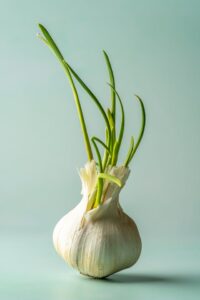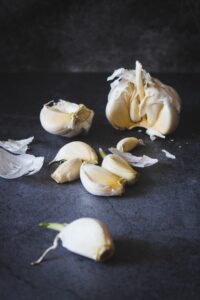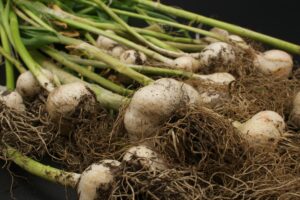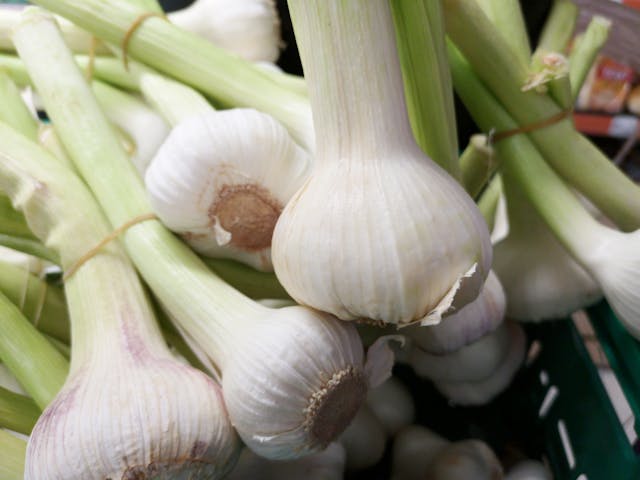Garlic, with its distinct flavour and numerous health benefits, is a kitchen staple in many households worldwide. Growing garlic at home not only ensures a fresh supply but also allows you to experience the satisfaction of harvesting your aromatic bulbs. Whether you have a garden or limited space indoors, cultivating garlic is a rewarding endeavour. In this guide, we’ll explore the step-by-step process of growing garlic, with a focus on indoor and container gardening methods.
How to Growing Garlic Indoors

Growing garlic indoors is a convenient option for those with limited outdoor space or adverse weather conditions. Follow these steps to successfully cultivate garlic indoors:
Selecting Garlic Bulbs:
Begin by selecting high-quality garlic bulbs from a reputable nursery or garden center. Look for firm bulbs with unblemished cloves and avoid bulbs that show signs of mold or decay. Choose varieties suited to indoor cultivation, such as softneck garlic, which tends to perform well in containers.
Preparing the Container:
Choose a deep container with drainage holes to prevent waterlogging. A pot with a diameter of at least 8 inches is ideal for growing garlic bulbs. Fill the container with a well-draining potting mix enriched with organic matter, such as compost or aged manure.
Planting Garlic Cloves:
Break apart the garlic bulb into individual cloves, taking care to keep the papery skin intact. Plant the cloves pointed end up, about 2 inches deep and 4 inches apart, in the prepared container. Ensure that the cloves are planted with the pointed end facing upward to facilitate proper growth.
Providing Optimal Growing Conditions:
Place the container in a sunny location that receives at least 6-8 hours of sunlight daily. If natural light is limited, supplement with a grow light to ensure adequate light exposure for the garlic plants. Maintain a consistent temperature range of 60-80°F (15-27°C) for optimal growth.
Watering and Feeding:
Keep the soil evenly moist throughout the growing season, but avoid overwatering, as garlic bulbs are susceptible to rot in soggy conditions. Water the plants whenever the top inch of soil feels dry to the touch. Additionally, fertilize the garlic plants every 3-4 weeks with a balanced liquid fertilizer to promote healthy growth.
Managing Pests and Diseases:
Monitor the garlic plants regularly for signs of pests such as aphids, thrips, or fungal diseases like white rot or rust. Control pests by manually removing them or using organic insecticidal soap. Ensure good air circulation around the plants to prevent fungal diseases, and avoid overhead watering to reduce humidity levels.
How to Grow Garlic in Pots

Growing garlic in pots is a versatile option that allows you to enjoy fresh garlic even in small spaces. Follow these steps to successfully grow garlic in pots:
Selecting Garlic Bulbs:
Choose high-quality garlic bulbs suited to your growing region and climate. Select varieties that are well-adapted to container cultivation, such as hardneck or softneck garlic. Avoid planting garlic from the grocery store, as it may be treated with growth inhibitors.
Preparing the Pot: Select a large, sturdy pot with drainage holes at the bottom to prevent waterlogging. A pot with a diameter of at least 12 inches and a depth of 8-10 inches is suitable for growing garlic bulbs. Fill the pot with a well-draining potting mix enriched with organic matter.
Planting Garlic Cloves:
Break apart the garlic bulb into individual cloves, leaving the papery skin intact. Plant the cloves pointed end up, about 2 inches deep and 6 inches apart, in the prepared pot. Ensure that the cloves are planted with the pointed end facing upward to facilitate proper growth.
Providing Optimal Growing Conditions:
Place the pot in a sunny location with 6-8 hours of sunlight daily. If growing garlic indoors, position the pot near a south-facing window or use a grow light to supplement natural light. Maintain a consistent temperature range of 60-80°F (15-27°C) for optimal growth.
Watering and Feeding:
Keep the soil consistently moist throughout the growing season, but avoid waterlogging, as garlic bulbs are prone to rot in soggy conditions. Water the plants whenever the top inch of soil feels dry to the touch. Additionally, fertilize the garlic plants every 3-4 weeks with a balanced liquid fertilizer to promote healthy growth.
Managing Pests and Diseases:
Monitor the garlic plants regularly for signs of pests such as onion flies, thrips, or fungal diseases like white rot or rust. Control pests by manually removing them or using organic insecticidal soap. Ensure good air circulation around the plants to prevent fungal diseases, and avoid overhead watering to reduce humidity levels.
Harvesting Garlic:
Garlic is typically ready for harvest when the tops begin to turn yellow and dry out, usually 8-10 months after planting. To harvest, carefully loosen the soil around the bulbs with a garden fork or shovel, taking care not to damage the bulbs. Gently lift the bulbs from the soil and brush off any excess dirt. Allow the harvested garlic bulbs to cure in a cool, dry, well-ventilated area for 2-3 weeks before storing.
Conclusion:
Growing garlic indoors or in pots is a rewarding and accessible gardening project that allows you to enjoy a fresh supply of this flavorful bulb year-round. By following the steps outlined in this guide, you can successfully cultivate garlic in containers or indoor settings, regardless of your gardening experience or available space. So roll up your sleeves, gather your supplies, and start growing your own delicious garlic today!

